The following article by Giacomo Guidi was originally published in Italian on May 9, 2011 and later revised for publication on May 15, 2011 and is reprinted courtesy of Ventidue Passi D'amore e Dintorni. The English translation is provided courtesy of Alex Passi. Danielle Passerini also wrote a foreward for the article. The first set of articles published by New Energy Times on this story are in issue 36.
Foreword
By Daniele Passerini, 22 Passi
At a time when just about everyone is attempting to replicate (in the absence of the required details) the nickel hydrogen low-energy nuclear reaction device claimed by Italian inventor and entrepreneur Andrea Rossi and his colleague Sergio Focardi, a retired physics professor from the University of Bologna, a 22 Passi reader, Giacomo "Jack" Guidi, an excellent engineer who never ceases to surprise me, has followed his brilliant discussion on patents with plausible speculations on the design of the core of Rossi's energy catalyzer (E-Cat) reactor. Guidi has produced magnificent drawings and cutaways. In his text, he also speculates on some of the possible secret catalysts that Rossi is using. Guidi is showing proof of his shrewdness here. Is this just a game, as he writes, or is he letting the E-cat out of the bag? What's sure is that, once again, he is providing us with material to start a good discussion.

Andrea Rossi (Image: Angelo Saso) |
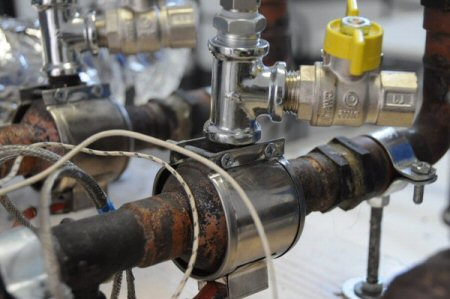
Reactor Core of Energy Catalyzer (Photo: Mats Lewan) |
Introduction
Please note that everything in this article is highly speculative, based on the limited information available from some images of the E-Cat and from the scant data released by Rossi and Focardi. Trying to understand how the possible invention-of-the-decade works is a fun game, but it will probably prove useful only to those who, like me, cannot restrain their brain when it begins to run wild.
After the first publication of this piece in Italian in the 22 Passi blog, many readers contributed to the conversation, commenting and offering interesting technical evalutations. This article is a translation of the second revision of the original article on 22 Passi.
My objective is to promote understanding of how a motley-looking piece of copper tubing may be about to revolutionize the world.
I hope that inventor Rossi does not mind my speculations. What follows here is but a synthesis of information published on various Web sites, beginning with 22 Passi and New Energy Times. Much general material has been culled from Wikipedia. To this synthesis, I added a few CAD drawings, a bit of imagination, and ― presto: reverse engineering of the roughest sort. And, of course: Do not try this at home!
The Catalyzer
Let's start with the tubing. Considering the comments from readers, I have identified four speculative versions of the E-Cat, starting from the simplest model to the most complicated. Each of these tries not to clash logically with the information offered by Rossi and Focardi, and each relies on a few basic engineering concepts in order to finalize a functional three-dimensional model.
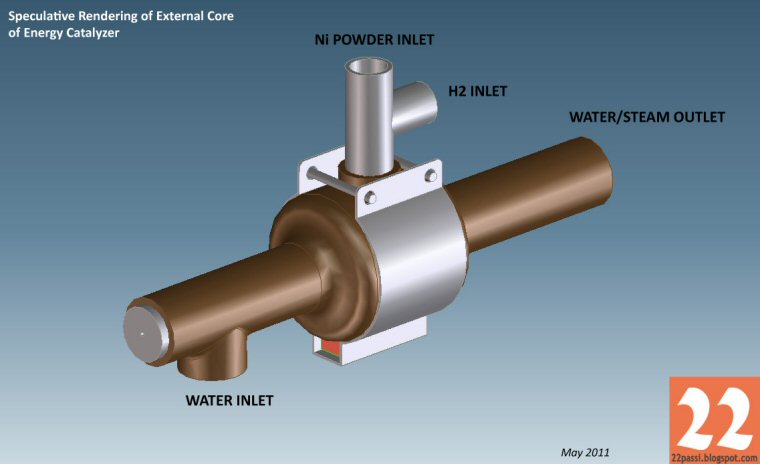
External View (Click image for larger version)
In the "Simple Chamber" version, the reactor has an inner stainless-steel chamber and an outer copper chamber. Material cannot exchange between the two chambers; only heat can. Water flows in the space between the two chambers to remove the heat. The nickel powder is introduced through the same pipe as for the introduction of hydrogen. (This part is pure speculation, because Rossi has made no public comments on this detail.) Photographs of the device show an end cap or possibly a vertical tap. Rossi probably opens this to pour in the mixture. The H2 is in direct contact with the Ni in the inner chamber of the catalyzer.
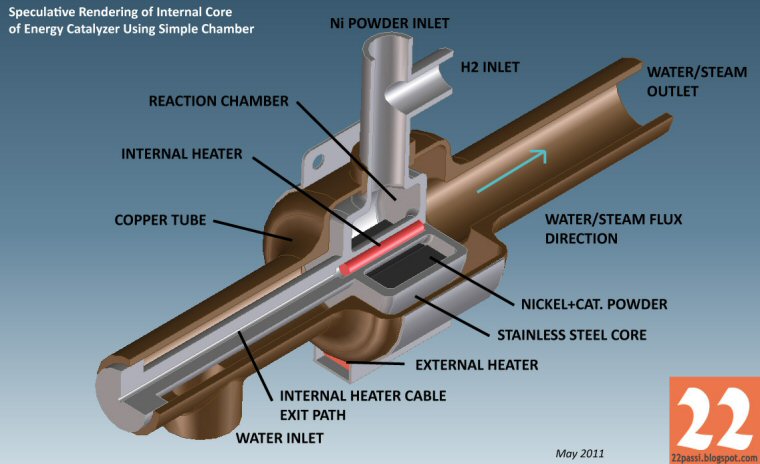
Simple Chamber Version (Click image for larger version)
A note about the core and water temperature is in order here. Considering the water flow and the amount of energy released, estimating the temperature inside the inner chamber of the core, and thus of the nickel, is very difficult. It likely could be very high, up to 500°C. This would fall in the range of values at which different metals loaded with hydrogen or deuterium have been shown to develop anomalous effects. Numerous researchers have published such reports, including Christos Stremmenos, a retired physicist from the University of Bologna, Francesco Piantelli, a retired biophysicist from the University of Siena, Francesco Celani, a physicist with the Italian National Institute of Nuclear Physics, and Yoshiaka Arata, a retired physicist from the University of Osaka.
The working temperature of the reactor is different from the initial temperature. Experimental data was taken by Rossi, and given to his associate Giuseppe Levi, professor of physics at the University of Bologna. Levi gave the data to Swedish professors Hanno Essén and Sven Kullander and they published their data in the Swedish magazine Ny Teknik in a travel report. According to their report, the reaction starts at 60°C; this is from the moment when Joule heating reaches its limit and there is a change in the reactor heating curve, presumably from the anomalous nuclear reaction.
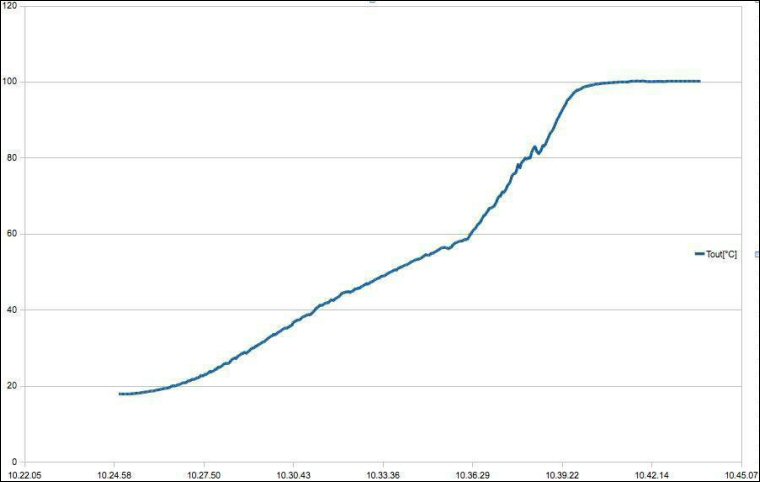
Output Temperature in Degrees Celsius from April 3, 2011 E-Cat Test. (Source history: Essén and Kullander travel report, Levi, Rossi)
In fuel cells, in addition to palladium, platinum is used as an interface layer between the hydrogen and the proton exchange membrane (PEM). Platinum dissociates H2 molecules and facilitates the penetration of hydrogen through the PEM. In the "Membrane Layer" version of the Rossi reactor shown below, platinum/palladium is in small grains, diffused in the mixture. If it were concentrated only on the chamber walls, it would hardly be effective on nickel that is not in contact with the wall.

Membrane Layer Version (Click image for larger version)
Rossi worked for the U.S. National Energy Technology Laboratory to develop high-efficiency devices for converting heat to electricity using the Seebeck effect. One of his U.S. patents mentions platinum as well as several technologies used in fuel cells. Thus, Rossi may have known about these materials in the years before he became fully involved in LENR.
But there is a problem. Rossi provided to the Swedish professors for analysis a sample of powder he used in the reactor. According to statements made by Kullander to Ny Teknik, the analysis showed only nickel, copper (10%) and iron (10%). And what about the secret catalyzer material? Perhaps Rossi removed it by some mechanical or chemical means. But if any residue had been revealed by the Swedish professors' mass spectroscope, it would have resulted in the loss of a trade secret. I don't believe that Rossi would have wanted to take such a risk. So perhaps the catalyzer material is not in the form we have imagined.
In this version, hydrogen and nickel are not in direct contact. They are separated by a membrane (or metallic layer) which acts exactly like the PEM in a fuel cell. The membrane probably composes a layer of platinum or palladium. It could be composed entirely of these elements or an alloy. In this case, there is no powder mixture. Here, however, only nickel in direct contact with the membrane would react. Therefore, the internal structure likely is such as to maximize the nickel-metal contact area. The membrane may not act as a separator but rather is simply immersed in a hydrogen-saturated atmosphere. And this leads us to the third version of our E-cat, the “Corrugated Sheet Metal” version.
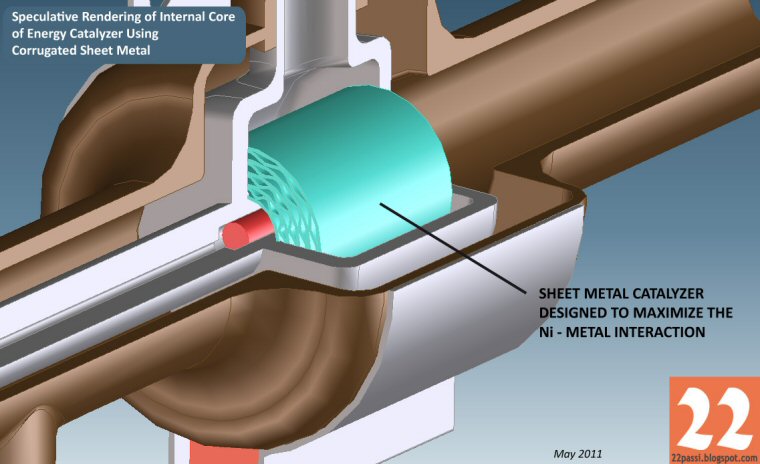
Corrugated Sheet Metal Version
The fourth version, “Small Chamber With Lead Layer,” is a variation of the first version but with a smaller-size reaction chamber. It also has a layer of lead between the external and internal chambers for added safety to block gamma rays (but only if they are low-energy) emitted by the internal chamber, assuming they are emitted.
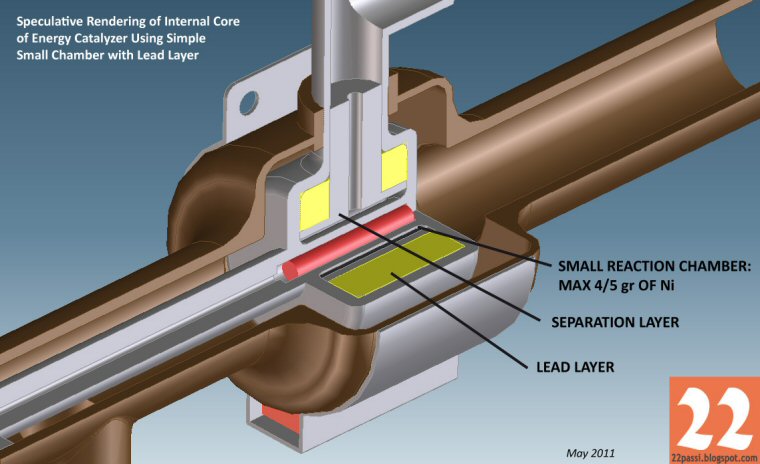
Small Chamber with Lead Layer (Click image for larger version)
The thermal energy is probably coming from the heating of the nickel interaction with the hydrogen. At any rate, the system's radioactive emissions are extremely low when compared to the number of nuclear reactions needed to generate the thermal energy measured, if any kind of conventional fission or fusion process were responsible. The processes involved in triggering the phenomenon, as well as which types of decays or processes would explain such a thermal output, are unclear.
I am undecided which among these four E-cat versions is most probable. I prefer the first only for reasons of simplicity. In the world of fuel cells, there are alternatives to platinum/palladium, and one substitute could be a mix based on iron, which was found in the E-Cat powder residues.
I may be leaving you with more doubts than certainties, but after all, that's what makes this topic exciting!
|

